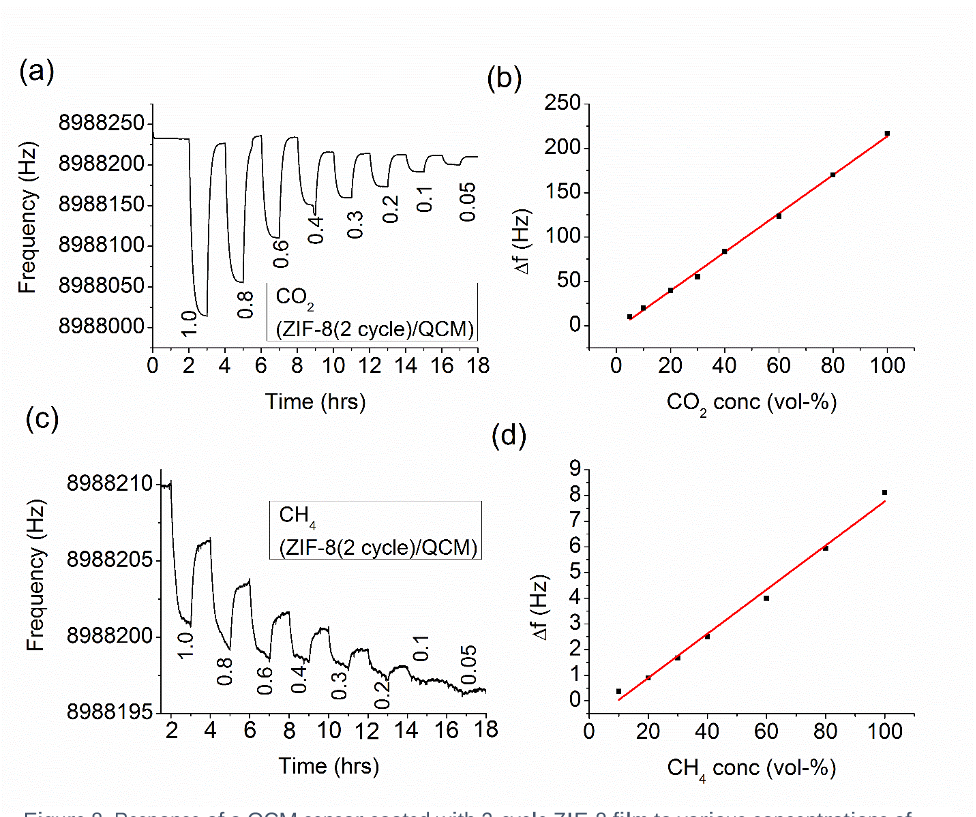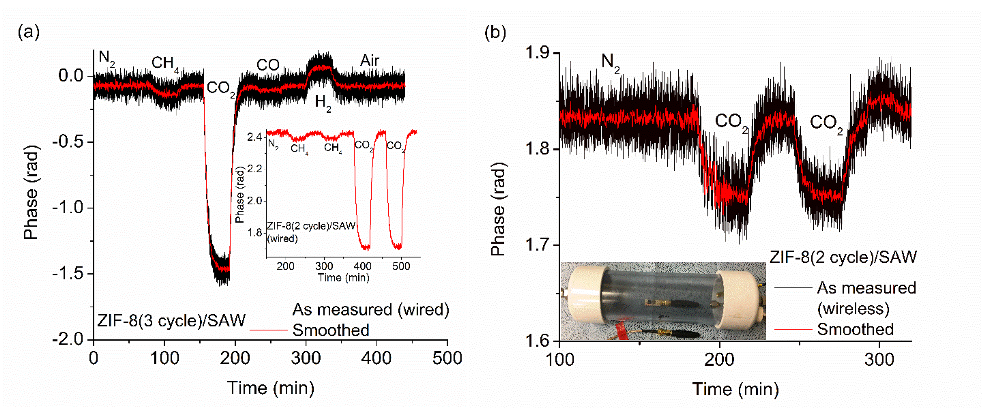
Accepted manuscript to publish in Nanoscale, DOI: 10.1039/C7NR09536H
1
Zeolitic imidazolate framework-coated acoustic sensors for room temperature
detection of carbon dioxide and methane
Jagannath Devkota
1,2,§
, Ki-Joong Kim
1,2
, Paul R. Ohodnicki
1,3,§
, Jeffrey T. Culp
1,2
, David W.
Greve
4,5
, and Jonathan W. Lekse
1
1
National Energy Technology Laboratory, Pittsburgh, PA 15236
2
AECOM Pittsburgh, PA 15236
3
Department of Materials Science and Engineering, Carnegie Mellon University, Pittsburgh, PA
15213
4
Department of Electrical and Computer Engineering, Carnegie Mellon University, Pittsburgh,
PA 15213
5
DWGreve Consulting, Sedona, AZ 86336
§
Corresponding authors: jagannath.devkota@netl.doe.gov; paul.ohodnicki@netl.doe.gov
Abstract
Integration of nanoporous materials such as metal organic frameworks (MOFs) with
sensitive transducers can result robust sensing platforms for monitoring gases and chemical vapors
for a range of applications. Here, we report on an integration of the zeolitic imidazolate framework
– 8 (ZIF-8) MOF with surface acoustic wave (SAW) and thickness shear mode quartz crystal
microbalance (QCM) devices to monitor carbon dioxide (CO
2
) and methane (CH
4
) at ambient
conditions. The MOF was directly coated on the custom fabricated Y-Z LiNbO
3
SAW delay lines
(operating frequency, f
0
= 436 MHz) and AT-cut Quartz TSM resonators (resonant frequency, f
0
=
9 MHz) and the devices were tested for various gases in N
2
at ambient condition. The devices were
able to detect the changes in CO
2
or CH
4
concentrations with relatively higher sensitivity to CO
2
,
which was due to its higher adsorption potential and heavier molecular weight. The sensors showed
full reversibility and repeatability which were attributed to the physisorption of the gases into the
MOF and high stability of the devices. Both types of the sensors showed linear responses relative

Accepted manuscript to publish in Nanoscale, DOI: 10.1039/C7NR09536H
2
to changes in the binary gas compositions thereby allowing to construct calibration curves which
correlated well with the expected mass changes in the sorbent layer based on mixed-gas
gravimetric adsorption isotherms measured on bulk samples. For 200 nm thick films, the SAW
sensitivity to CO
2
and CH
4
were 1.44×10
-6
/vol-% and 8×10
-8
/vol-%, respectively against the QCM
sensitivities 0.24×10
-6
/vol-% and 1×10
-8
/vol-%, respectively which were evaluated as the
fractional change in the signal. The SAW sensors were also evaluated for 100 nm – 300 nm thick
films, the sensitivities of which were found to increase with the thickness due to the increased
number of pores for adsorption of larger amount of gases. In addition, the MOF-coated SAW delay
lines had a good response in wireless mode, demonstrating its potential to operate remotely for
detection of the gases at emission sites across the energy infrastructure.
Graphical Abstract:

Accepted manuscript to publish in Nanoscale, DOI: 10.1039/C7NR09536H
3
1. Introduction
Greenhouse gas emissions such as carbon dioxide (CO
2
) and methane (CH
4
) from the
processing and use of fossil fuels create environmental concerns and challenges in fuel
transportation
1
. Even though sensors are available for detection and analysis of these gases, there
exist opportunities for enhanced monitoring capability of geographically distributed infrastructure
such as through advanced devices that are sufficiently low cost for ubiquitous deployment and can
be interrogated wirelessly. Examples include CH
4
leak detection for the natural gas and oil
infrastructure (e.g. pipelines, compressors, active and abandoned wells), CO
2
monitoring for
understanding plume migration within and near geological formations in carbon sequestration
applications, and detection of such species in wellbore integrity monitoring and drilling
applications amongst others. Therefore, a need exists for developing novel, cost-effective, and
reliable sensors with high sensitivity and selectivity as well as ability to operate wirelessly for
monitoring these gases. Surface acoustic wave (SAW) devices, which are highly sensitive, low
cost, small, and operational in wireless and passive modes, can satisfy all requirements through
selective detection of chemical species at ambient conditions when coated with proper sensing
materials
2
. In these sensors, the coating materials play a key role in interacting with the target
gases and coupling the interaction with the propagating wave characteristics. Their properties not
only determine the selectivity, reversibility, and repeatability but also can affect the sensitivity and
response kinetics
2
. Variety of materials such as metal oxides
3, 4
, carbon nanotubes
5
, graphene-
based composites
6
, and polymers
7-10
have been applied on SAW devices for gas detection.
However, the majority of these materials have either poor interaction with gases at ambient
conditions or poor selectivity thereby limiting their applications. For instance, the sensors based
on metal oxides can possess high sensitivity and can be engineered for adequate selectivity, but

Accepted manuscript to publish in Nanoscale, DOI: 10.1039/C7NR09536H
4
they need elevated temperatures for interaction with gases whereas those based on polymers have
limited sensitivity and selectivity. Inert nature of CH
4
adds extra complication in developing a
robust sensor for its monitoring even in emission sites. To address these issues, there is a need of
(i) identifying novel materials that can incorporate large amount of specific gases by adsorption at
ambient conditions and (ii) integrating them with sensitive transducers like SAW devices.
In recent years, a novel class of nanoporous crystalline materials composed of metallic ions
and organic linkers, the metal-organic frameworks (MOFs), have attracted considerable attention
in sensing and other applications due to their diverse structure with uniform pores, large surface
area, tunable gas adsorption properties at ambient conditions as well as at high pressures, and good
thermal stability
11-14
. They can physisorb large amount of gases into their pores whose structure,
aperture, and sizes can be engineered to tune the adsorption for desired selectivity and sensitivity
11, 15
.They have been extensively studied for high pressure applications including gas storage,
separation, and heterogeneous catalysis
16, 17
. However, their use as sensing materials is still in
their infancy due to challenges to integrate them with electronic devices including acoustic
transducers
13, 15, 18-24
. Zeitler et. al. reported a computational study to investigate a possibility of
incorporating a range of MOFs with QCM, SAW, and microcantilever devices for CH
4
detection
with high sensitivity
25
. They pointed out that the performance of SAW sensors coated with MOFs
can have better sensitivity than that of QCM sensors. Yamagiwa et al. integrated Cu
3
(BTC)
2
and
Zn
4
O(BDC)
3
with QCM resonators for detection of humidity and volatile organic compounds
26
.
Similarly, some other research groups also applied Cu
3
(BTC)
2
on QCM resonators to detect
humidity and some organic analytes
20, 27
. Robinson et al. integrated Cu
3
(BTC)
2
with SAW devices
to develop humidity sensors
14
. More recently, Paschke et al. applied MFU-4 and MFU-4l MOFs
on SAW devices and investigated their gas uptake kinetics
21
. Besides a few of these, thousands

Accepted manuscript to publish in Nanoscale, DOI: 10.1039/C7NR09536H
5
of other MOFs reported to date (and hundreds of thousands more MOFs conceivable) display a
wide range of gas adsorption behaviors and thereby open the possibility of tailoring adsorption-
based sensors to a particular analyte and sensor arrays for compositional analysis of
multicomponent mixtures.
Although there are some computational approaches
28
to screen MOFs as sensing layers,
experimental investigations are critical for determining appropriate methods of fabricating dense
thin films on a sensor surface and verifying that the gas adsorption properties of the bulk material
are preserved when incorporated into a sensing device. Here, we investigate the potential of ZIF-
8 as a sensing layer on SAW and QCM devices for detection of various concentrations of CO
2
and
CH
4
in N
2
at room temperature and atmospheric pressure. It is a non-conducting crystalline (space
group: I43m) MOF composed of zinc ions and 2-methylimidazole organic linkers (Figure 1(a))
29,
30
. This particular MOF was chosen as it is well characterized for its structural as well gas
adsorption properties and can be grown as uniform thin films on various substrates by simple
methods
19, 29, 31
. As such, ZIF-8 provides an excellent model material to evaluate how effectively
the gas adsorption properties of the bulk material can be transferred to a functional device. Its
structure contains large cages (diameter 11.6 Å) with narrow apertures (width 3.4 Å) formed by
six-membered rings
19
. While the crystalline pore aperture is smaller than the kinetic diameters of
N
2
and CH
4
, the ligands which frame the pore opening are able to move slightly and increase the
effective pore aperture. Due to this ligand flexibility, the sieving aperture in ZIF-8 is approximately
6 Å, which is more than large enough for the adsorption of small gases such as CO
2
, CH
4
, and N
2
through physical processes
32
. While this MOF is known to have only moderate gas adsorption
selectivity; low water affinity and the good stability at ambient conditions of the material make it
a good candidate for niche applications in humid environments such as leak monitoring along





